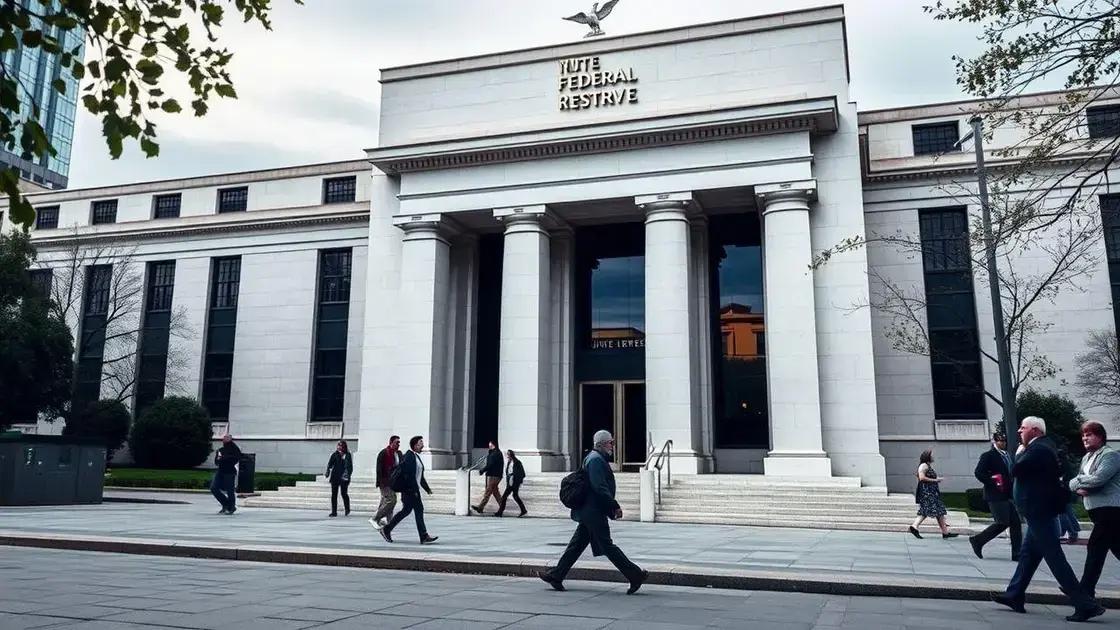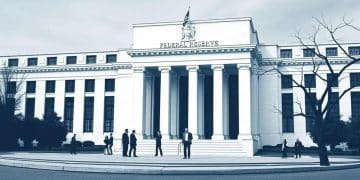Federal Reserve maintains restrictive monetary policy amid inflation

The Federal Reserve maintains a restrictive monetary policy to combat inflation, affecting borrowing costs and economic recovery while influencing consumer spending and financial decisions.
Federal Reserve maintains restrictive monetary policy as a critical measure to combat rising inflation. Have you felt the pinch in your wallet lately? Let’s explore how these policies shape our financial landscape.
Understanding the Federal Reserve’s Policies
Understanding the Federal Reserve’s policies is essential for grasping how they influence our economy. These policies shape interest rates, lending, and the overall economic climate. When the Federal Reserve sets a restrictive policy, it aims to slow down inflation and stabilize the economy.
Key Functions of the Federal Reserve
The Federal Reserve plays a crucial role in managing the U.S. economy. Among its responsibilities are:
- Conducting Monetary Policy: The Fed adjusts the money supply to either stimulate or cool down economic activity.
- Regulating Banks: It ensures that banks operate within safe and sound parameters.
- Maintaining Financial Stability: The Fed monitors risks in the financial system to prevent crises.
- Providing Banking Services: The central bank acts as a bank for the U.S. government and other banks.
When we say the Federal Reserve maintains a restrictive monetary policy, it generally means that they have raised interest rates or are limiting the growth of the money supply. This is designed to curb inflation by making borrowing more expensive. For example, imagine wanting to take out a loan to buy a house; with higher interest rates, you might think twice, resulting in fewer loans being taken out.
The Impact of Restrictive Policies
Implementing these policies does not come without consequences. Higher interest rates can:
- Reduce consumer spending, leading to slower economic growth.
- Impact investment decisions by businesses.
- Cause fluctuations in stock markets as investors reassess risk.
- Influence foreign exchange markets, affecting the value of the dollar.
All these factors play a role in how effectively the economy functions and how quickly it can recover from downturns. While the aim is to keep inflation in check, the real-world impacts of these policies can be complex and sometimes painful for everyday consumers.
In conclusion, understanding the Federal Reserve’s policies provides insight into how economic decisions made at the top can have ripple effects throughout the economy, influencing everything from your mortgage to the prices of goods at the store.
Current Inflation Trends and Their Causes

Current inflation trends are a hot topic as consumers feel the effects on their daily lives. Understanding these trends helps us grasp why prices are rising. Factors such as supply chain disruptions and increased demand have driven inflation higher in recent months.
Key Factors Contributing to Inflation
Several elements contribute to the current rise in inflation. Here are some significant factors:
- Supply Chain Issues: Disruptions in global supply chains have limited the availability of goods, causing prices to soar.
- Labor Shortages: Many industries face difficulties hiring workers, leading to higher wages which businesses may pass on to consumers.
- Increased Demand: As economies reopen, demand for goods and services has surged, further straining supply.
- Government Stimulus: Financial aid during the pandemic has contributed to increased consumer spending.
These factors create a cycle where rising costs lead to higher consumer prices. For instance, when companies experience higher production costs, they often increase prices to maintain profit margins. This scenario affects everything from grocery prices to gasoline costs.
Examples of Rising Prices
Many consumers have noticed the pinch in their wallets. Here are some common items that have seen significant price increases:
- Groceries: Basic items like bread, milk, and eggs have become more expensive.
- Gasoline: Fuel prices have fluctuated greatly, often leading to higher transportation costs.
- Housing: Rent and home prices have surged in various markets.
- Used Cars: A shortage of new vehicles has driven up the prices of pre-owned cars.
Understanding these current inflation trends is essential for consumers and businesses alike. By keeping informed, one can make better financial decisions that account for these changing economic conditions.
Impact on Borrowing and Interest Rates
The impact on borrowing and interest rates is closely tied to the Federal Reserve’s monetary policy. When the Fed maintains a restrictive monetary policy, it often results in higher interest rates. This affects consumers and businesses alike, making it essential to understand how these changes influence financial decisions.
Higher Interest Rates
As the Fed raises interest rates, the cost of borrowing increases. This can affect various types of loans, including:
- Mortgage Loans: When interest rates rise, mortgage payments become more expensive, which can cool down the housing market.
- Personal Loans: Individuals may hesitate to take out loans for major purchases like cars or renovations.
- Business Loans: Higher interest rates can deter small businesses from expanding or investing in new projects.
The connection between the Fed’s policies and consumer behavior is significant. With less incentive to borrow, overall economic growth can slow down. For instance, if people hold off on buying homes, it can lead to a slowdown in home construction and related industries.
Effects on Savings and Investments
While higher interest rates can discourage borrowing, they can also benefit savers. Individuals may receive better returns on savings accounts and fixed-income investments. Here are some implications:
- Increased Savings Rates: Savers can take advantage of higher interest rates, leading them to save more.
- Investment Adjustments: Investors may shift their portfolios to include more bonds that benefit from rising interest rates.
- Consumer Spending Reduction: Higher borrowing costs can lead to decreased consumer spending, which is vital for economic growth.
Understanding the impact on borrowing and interest rates helps individuals and businesses make informed financial choices. Anticipating these changes can guide decisions about loans, savings, and spending habits as the economy evolves.
Future Projections and Economic Recovery

Future projections for the economy depend heavily on the Federal Reserve’s actions and the broader economic environment. As inflation pressures ease, experts are closely watching indicators that suggest how monetary policy will evolve.
Economic Recovery Trends
Many economists believe that the economy will gradually recover from the effects of recent challenges. Here are some key trends to watch:
- Employment Growth: With businesses reopening, job creation is expected to accelerate, lowering the unemployment rate.
- Consumer Spending: As confidence builds, consumers may increase spending, which is crucial for driving economic growth.
- Investment in Infrastructure: Government stimulus may lead to significant investments in infrastructure projects, creating jobs and boosting demand.
- Technological Advancements: Businesses adopting new technologies can improve productivity, facilitating a smoother recovery.
However, the recovery is not guaranteed to be smooth. Events like international conflicts, supply chain issues, or new COVID-19 variants could disrupt progress. As a result, the Federal Reserve’s response to these changing conditions will remain critical.
Interest Rate Adjustments
In response to economic signals, the Federal Reserve may adjust interest rates. If inflation remains high, rates could continue to rise, which affects borrowing costs. Here’s how that plays out:
- Slower Growth if Rates Rise: Higher rates might slow down economic activity as borrowing costs increase.
- Potential for Lower Inflation: Adjusting rates is aimed at controlling inflation, which could stabilize prices.
- Long-Term Stability: A well-managed interest rate strategy can foster long-term economic health and recovery.
As we look to the future, keeping an eye on these factors will help us understand how effectively the economy can rebound. Adjustments by the Federal Reserve will have significant implications for consumers, businesses, and overall economic health.
In conclusion, understanding the Federal Reserve’s monetary policies is vital for grasping the current economic landscape. The impact of restrictive measures on inflation, borrowing, and interest rates shapes both individual financial decisions and broader economic conditions. As we navigate through future projections and potential recovery, staying informed about these policies allows consumers and businesses to adapt effectively. By keeping a close eye on economic indicators and the Fed’s actions, we can better prepare for what lies ahead. The road to recovery may have challenges, but with keen awareness, we can make informed choices for a more stable financial future.
FAQ – Frequently Asked Questions about Federal Reserve Policies and Economic Impact
What is the Federal Reserve’s role in the economy?
The Federal Reserve manages monetary policy, aiming to promote economic stability and control inflation.
How do interest rate changes affect consumers?
Higher interest rates can increase the cost of loans, making borrowing more expensive for consumers.
What factors contribute to inflation?
Inflation can be driven by supply chain disruptions, increased demand, and rising production costs.
How can consumers prepare for economic changes?
Staying informed about economic indicators and Federal Reserve policies can help consumers make better financial decisions.






